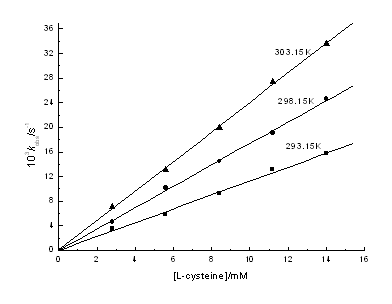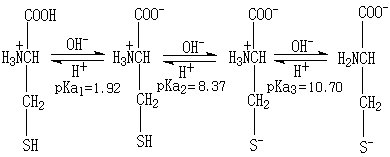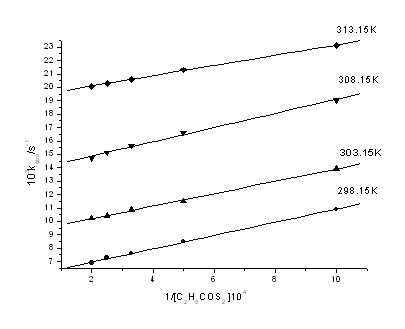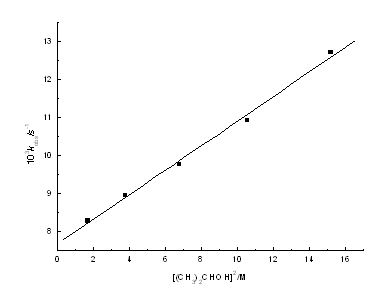http://www.chemistrymag.org/cji/2008/104021pe.htm |
Apr. 1,
2008 Vol.10 No.4 P.21 Copyright |
(College of Chemistry and Environmental Science, Hebei Uinversity, Baoding 071002, Hebei Province, China)
Abstract A novel platinum xanthate complex (PtCl2(S2COC2H5)2) has been synthesised and characterized by IR. Reduction of the trans-dichlorobis(O-ethyldithiocarbonato) platinum(IV) by L-cysteine has been investigated at 298.15 K in the rang 3 ≤ pH ≤ 7 using the conventional spectrophotometry. The reaction display an overall second-order rate law: -d[Pt(IV)]/dt = k'[Pt(IV)][L-cysteine]tot, where [L-cysteine]tot is the total concentration of L-cysteine. The pH dependence of k
' is ascribed to parallel reductions of trans-dichlorobis(O-ethyldithiocarbonato) platinum(IV) by various protolytic species of L-cysteine, the relative contributions of which change with pH. Electron transfer from thiol to Pt(IV) complex is suggested to take place as a reductive elimination process through an attack by sulfur at one of the mutually trans chloride ligands. It was found that the pseudo-first order rate constant kobs increased with increasing concentration of 1/[-S2COC2H5], which involves a pre-equilibria. The reaction mechanism was proposed can explain all the experimental observations.Keywords L-cysteine, Platinum xanthate complex, Reduction, Kinetics and mechanism, Synthesis
1. INTRODUCTION
Platinum complexes are now a well-established class of cancer chemotherapy agents.
Cisplatin is widely used in treatment of several human cancers including those of tests,
ovaries and bladder[1-4]. However, its spectrum of antitumor activity is
narrow, and its clinical use is limited by severe dose toxicities such as nephrotoxicity,
ototoxicity, neutotoxicity, nausea, vomiting, and myelosuppression [1,3,5-9 ].
Therefore, researchs in many laboratories around the world have been actively engaged in
synthesizing and studying cisplatin and its analogues, hoping to discover a better
antitumor drug that is less toxic, has better antitumor activity, and is fairly soluble in
water. The result was carboplatin and 254-S, which have been approved for clinical use and
several others are on clinical trials [3, 5, 10, 11].
A considerable part of the effort in the developing a new generation of
platinum-based anticancer drugs is to find novel platinum(IV ). Indeed, many platinum(IV)
complexes have been found to be anticancer active [12-14 ]; cis-[Pt(NH3)2Cl4],
iproplatin, tetraplatin, JM335 and JM216 (cis,cis-,trans-[Pt(Cl2(NH3)(cyclo-C6H11NH2)(CH3COO)2])
can be regarded as the represe- ntatives for this developing process [1,15-20].
Iproplatin(cis,trans,cis-[PtCl2(OH)2(isopropylamin-
e)2]) was selected from a range of platinum(IV) complexes synthesized by Tobe
and coworkers for its high solubility [21]. Iproplatin was sufficiently well
tolerated to enter phase II and III clinical trials,but
was ultimately found to be less active than cisplatin and so has not entered widespread
clinical use [22]. Tetraplatin show great promise in preclinical studies but
caused severe neurotoxicity in treated patients and the trials were subsequently abandoned
at the phase I level. JM216 is a rationally designed drug which was in phase III trials,
but trials were abandoned due to variability in drug uptake [23].
Recently a platinum complex based on sulfur as complex-forming atoms,
bis(O-ethyldithiocarbonato)platinum(II), named thioplatin, with antitumoral
activity against a number of human tumor lines was described. It was found that thioplatin
displayed significantly higher cytotocicity when tumor cells were cultivated in media of
pH of 6.8 compared to media of pH 7.4. Because in solid tumors a pH of 6.8 and lower has
been frequently observed [25], an improved therapeutic index with thioplatin
could be expected. Indeed, thioplatin displayed antitumoral activity on human tumors
xenotransplanted in nude mice, which was comparable to cispaltin. Yet a significantly
lower toxicity on kidney, small intestines, and white blood cell count was encountered
[24]. Twenty different bis(O-ethyldithiocarbonato)platinum(II), complexes
were synthesized and tested for cytotoxic activity in a panel of six human tumor lines by
Wolfgang Friebolin and his coworkers. Derivatives with up to 7-fold increased activity
compared to thioplatin and up to 25-fold more activity than cisplatin were identified.
Bis(O-alkyldithiocarto)platinum(II) complexes with short n-alkyl
chains were superior to compounds with long n-alkyl chain [26].
Conversion of platinum(II) complexes to platinum(IV) analogues is a
approach to moderate the toxicity of platinum(II) complexes [27]. In fact, much
has been done to develop more stable Pt(IV) analogues [28] that would
facilitate clinical evaluation and also from the view point of modulating favorable
interactions with target DNA [29], increase the spectrum of antitumor activity.
The reduction potentials of Pt(IV) complexes are dependent on the nature of the axial and
equatorial ligands, but the axial ligands generally exert the stronger influence,
reduction occurs most readily when the axial ligands are chloro [8]. In this
paper, PtCl2(S2COC2H5)2, as shown
in Chart 1, that a novel anti-cancer prodrug thioplatin's analogue was synthesized and
characterized. In present study, we report here the kinetics and mechanism studies of its
reduction by L-cysteine in vitro. The purpose of this study is to have a better understand
of the reduction process and mechanism and to give some information about design of new
drug

Chart 1 PtCl2(S2COC2H5)2
2. EXPERMENTAL SECTION
2.1 Chemicals and solutions
L-cysteine was obtained from Shanghai zhengxiang Chemical Reagent Company. K2PtCl4
was purchased from Alfa Aesar. NaCl, NaClO4, HClO4, isopropyl
alcohol and potassium ethyl xanthate were obtained either from Beijing Chemical Reagent
Company (Beijing, China) or from Tianjin Chemical Reagent (Tianjin, China). All the above
reagents were of either analytical grade or reagent grade and used as received without
further purification. All solutions were prepared with doubly distilled water.
2.2. Synthesis and Characterization of PtCl2(S2COC2H5)2
The Pt(S2COC2H5)2 was synthesized in
accordance to the literature [26]. Postassium ethyl xanthate was reacted with
dipotassium tetrachloroplatinate (II). A solution of 0.6mmol potassium ethyl xanthate in
5mL of water was added to 0.6mmol of K2PtCl4 dissolved in 10mL of
water. Immediate precipitation of a yellow solid could be observed. The reaction
progressed slowly. The mixture was stirred at room temperature for 4 h. Then Cl2
was blowed into the mixture for 3 h, followed by purging with nitrogen for 2 h in order to
remove dissolved chlorine. The mixture was filtered, washed three times with distilled
water, and was crystallized from acetone. The product was dried in vacuo (yield: 145.4mg,
47.7% ). IR (KBr): 3419 (m), 2983 (w), 2935 (w), 1632 (w), 1397 (w), 1195 (s), 1060 (w),
879 (w), 597 (w).
2.3. Spectral and kinetic measurements
UV-visible spectra were recorded on a TU-1901 spectrophotometer (Beijing, China) and
quartz cells with a 1.00 cm optical pathlength were used. The spectrophotometer was
equipped with a cell compartment which was thermostated by circulation of water from a
thermostat (BG-chiller E10, Beijing Biotect Inc., Beijing). Temperature of solutions in
cells can be controlled to ±0.2℃ when cells are put
in the compartment. Two reaction solutions, one containing known concentrations of PtCl2(S2COC2H5)2,
KS2COC2H5, NaCl, (CH3)2CHOH, and
the other containing desired concentrations of L-cysteine, HClO4 and NaClO4,
were thermostated for at least 20 min before mixing each other. The function of NaClO4
was to adjust the ionic strength (m) in the reaction solutions and
3. RESULT AND DISCUSSION
3.1 Kinetic
The kinetic traces for reduction of Pt(IV) to Pt(II) can be described by single
exponentials and variation of [Pt(IV)] and added [Cl-] in the condition of our
experimental system do not affect the rate constants (Table 1,2), suggesting that the
reduction is first-order in platinum(IV) complexes.
Table 1 103kobs/s-1 varying
with different concentrations of [Pt(IV)] at 298.15K. Reaction conditions: [ClO-4]
= 0.5 M, [Cl-] = 3 mM, [L-cysteine] = 5.6 mM,[-S2COC2H5]= 0.1 mM,
[(CH3)2CHOH] = 1.95 M, pH = 4.
105c/M |
2.8 |
1.4 |
4.2 |
5.6 |
7.0 |
103kobs/s-1 |
9.79 |
9.82 |
9.81 |
9.82 |
9.78 |
Table 2 103 kobs/s-1 varying with different concentrations of [Cl-] at 298.15K. Reaction conditions: [ClO-4] = 0.5 M, [Pt(IV)] = 0.056 mM, [L-cysteine] = 5.6 mM,[-S2COC2H5] = 0.1 mM, [(CH3)2CHOH] = 1.95 M, pH= 4.
c/M |
0.001 |
0.002 |
0.003 |
0.004 |
0.005 |
103kobs/s-1 |
9.97 |
10.36 |
9.97 |
9.64 |
9.99 |
Plots of kobs versus [L-cysteine] are linear and
pass through the origin at different temperature, as shown in Fig. 1, proving that the
reduction is also first-order in L-cysteine.
Thus, the rate law is
described by Equation (1), where [L-cysteine] represents the total concentration of
reductant.
![]() = kobs[Pt(IV)] = k'
[L-cysteine] [Pt(IV)] (1)
= kobs[Pt(IV)] = k'
[L-cysteine] [Pt(IV)] (1)
Kinetics and mechanism for oxidation of L-cysteine by Pt(IV) was
investigated under the condition of 298.15K and pH 4, and the oxidation reaction also
follow an overall second-order rate law. Keeping other condition constant, plots of kobs
versus 1/[-S2COC2H5] (0.1-0.5 mM) are linear
at different temperature as shown in Fig. 2, kobs increases with
increasing 1/[ -S2COC2H5 ]. The values of kobs
versus [(CH3)2CHOH] and pH have been collected and displayed in Fig.
3 and Table 3.

Fig.1 Pseudo first-order rate constants, kobs,
as a function of [L-cysteine]. Reaction conditions: [Pt(IV)] = 0.056 mM, [ClO-4]
= 0.5 M, [-S2COC2H5] = 0.1 mM, [(CH3)2CHOH]
= 1.95 M, pH = 4, [Cl-] = 3 mM.
3.2 Protolytic equilibria
Under the reaction conditions in the present work, we keep pH 4 constant during the
reaction course. In aqueous solutions, the ionization of L-cysteine depends on pH and can
be described as follows [30]

Chart 2
It can be calculated from
those protolysis data that more than 99.17% of amino acid is existing in the form of H3N+CH(CH2SH)COO-
in pH 4. Based on the above equilibrium constants, calculations reveal that under our
experimental conditions H3N+CH(CH2SH)COO- is
the predominant species whereas the H3N+CH(CH2SH)COOH and
H3N+CH(CH2S-)COO- make a very minor
contribution to the total [L-cysteine] speciation are very trifling and negligible. Thus,
the total concentration of [L-cysteine], [L-cysteine]tot , can be expressed by:
[L-cysteine]tot = [H3N+CH(CH2SH)COO-]
+[H3N+CH(CH2SH)COOH]+[H3N+CH(CH2S-)COO-]≈[H3N+CH(CH2SH)COO-] (2)
[H3N+CH(CH2SH)COO-]= ![]() (3)
(3)
3.3 Reaction mechanism
The kobs-pH values shown in Table 3 clearly demonstrate that the
deprotonated L-cysteine species are more reactive than the protonated ones. kobs
increases with the increasing pH.
Table 3 pseudo first-order rate constants kobs
with pH at 298.15K. Reaction conditions: [Pt(IV)] = 0.056 mM, [ClO-4]
= 0.5 M, [Cl-] = 3 mM, [L-cysteine] = 5.6 mM,[-S2COC2H5] = 0.1 mM,
[(CH3)2CHOH] = 1.95 M.
pH |
3 |
4 |
5 |
6 |
7 |
103kobs/s-1 |
8.87 |
9.67 |
10.02 |
10.55 |
11.86 |
The dramatic change of kobs with pH has also been
described in the reduction of trans- [Pt(CN)4Cl2]2- by T.
Shi [31]. The pH dependence of kobs is attributed to the
displacement of protolytic equilibria involving the various anionic species of the
L-cysteine as shown in Chart 2. The anionic species of L-cysteine reduce PtCl2(S2COC2H5)2
in parallel reactions in which the contribution of each pathway to the overall reduction
depends on the relative concentration and reducing power of the various L-cysteine
species. It can be calculated from those protolysis data as shown in Chart 2 in pH 4 that
H3N+CH(CH2SH)COO- is the predominant species,
others is very trifling and negligible.
It is expected that
initial substitution of the coordinated chlorides by L-cysteine is unlikely, since the
platinum(IV) is essentially substitution inert and variation of chloride concentration
does not affect the reduction rate. Previous mechanistic studies on reductions of platinum
(IV) halide complexes by inorganic [32-34] and biological [31,35]
reductant have been shown that electron transfer involves reductive elimination through
nucleophilic attack by the reductant on a halide coordinated trans to a good leaving
group. Reductive elimination reaction of platinum(IV) compounds via the halide-bridged
activated complex are formally equivalent to a transfer of Cl+ from the
oxidizing Pt(IV) center to the reducing nucleophile, followed by loss of the trans ligand[31-34]
as follow (where RSH = L-cysteine).

Chart 3
The intermediate oxidation
products, RSHCl+ and RSCl, undergo the rapid subsequent reaction (4)-(6),
leading to the final products RSSR [8, 36].
RSHCl+ +H2O →RSOH + Cl+
+ 2H+ (4)
RSCl + H2O → RSOH + Cl- + H+
(5)
RSOH + RSH → RSSR + H2O (6)
RSOH +RS- → RSSR + OH- (7)
RSHCl+ and RSCl will hydrolyze in a fast subsequent step
according to Equations (4) and (5) ,and RSOH formed will trapped by RSH and RS-
according to Equations (6) and (7), respectively [31].
The fact that thiols attack coordinated chloride through the sulfur
atom is described by Kelemu and his colleagues, the deprotonation of the thiol group-SH
increases the reduction rate. The fact is consistent with our experimental data, RSH
produces more RS- with pH increasing that will increase the reduction rate.
It is clear from the Fig.2 that kobs decrease with [-S2COC2H5]
increasing, [-S2COC2H5],
this kind of reaction trend has been interpreted in terms of a pre-equilibrium in which
PtCl2(S2COC2H5)2 equilibrates with
[PtCl2(CH3)2CHOHS2COC2H5].
It displays in equation (8).

Fig. 2 Pseudo first-order rate constants kobs as a
function of [-S2COC2H5] at four temperatures.
Reaction conditions: [Pt(IV)] = 0.056 mM, [ClO-4] = 0.5 M, [(CH3)2CHOH]
= 1.95 M, pH = 4, [Cl-] = 3 mM, [L-cysteine] = 5.6 mM.
PtCl2(S2COC2H5)2+2(CH3)2CHOH![]() [PtCl2((CH3)2CHOH)2S2COC2H5]+-S2COC2H5
(8)
[PtCl2((CH3)2CHOH)2S2COC2H5]+-S2COC2H5
(8)
![]() (9)
(9)
Moreover, it was assumed that [PtCl2((CH3)2CHOH)2S2COC2H5]
was the reactive species whereas PtCl2(S2COC2H5)2
had less reactive.
It is noteworthy that the kobs increase rapidly with
increasing [(CH3)2CHOH], the plots kobs versus [(CH3)2CHOH]2
are linear, as shown in Fig. 3,indicating that [PtCl2((CH3)2CHOH)2S2COC2H5]
is the reactive species.

Fig. 3 Pseudo first-order rate constants kobs
as a function of [(CH3)2CHOH]2 for the reduction of
Pt(IV) by L-cysteine. Reaction conditions : [Pt(IV)] = 0.056 mM, [ClO-4]
= 0.5 M, pH = 4, [Cl-] = 3 mM, [L-cysteine] = 5.6 mM,[-S2COC2H5] = 0.1 mM.
With PtCl2(S2COC2H5)2
and PtCl2((CH3)2CHOH)2S2COC2H5
acting in the two parallel pathways, reactions (8), (10) and (11) describe the present
systems.
PtCl2(S2COC2H5)2 + RSH ![]() RSHCl+ + Cl- + Pt(S2COC2H5)2
(10)
RSHCl+ + Cl- + Pt(S2COC2H5)2
(10)
[PtCl2((CH3)2CHOH)2S2COC2H5]+RSH![]() RSHCl+ + Cl-+ [Pt((CH3)2CHOH)2S2COC2H5]
(11)
RSHCl+ + Cl-+ [Pt((CH3)2CHOH)2S2COC2H5]
(11)
The rate law is then given by Equation (12),where
[L-cysteine]tot=![]() and [Pt(IV)] =
[PtCl2(S2COC2H5)2]+ [PtCl2((CH3)2CHOH)2S2COC2H5].
and [Pt(IV)] =
[PtCl2(S2COC2H5)2]+ [PtCl2((CH3)2CHOH)2S2COC2H5].
![]() = kobs[Pt(IV)]
= kobs[Pt(IV)]
= k' [L-cysteine]tot [Pt(IV)]
![]()
![]()
The PtCl2((CH3)2CHOH)2S2COC2H5
was the reactive species, k2 >>1, K << 1, thus K[(CH3)2CHOH]2
can be neglected in the rate law, it is confirmed by our calculation . Reaction (11)
is the rate-determining step.
 (12)
(12)
Or  (13)
(13)
From Equation (13), the plots of kobs versus [(CH3)2CHOH]2
are straight line and increase with [(CH3)2CHOH]2
increasing, the value of kobs versus 1 / [-S2COC2H5]
is line and increase with increasing 1 / [-S2COC2H5],
[Cl-] does not affect the rate constant, plots of kobs versus
[L-cysteine] are linear, and increase with increasing pH. These are consistent with our
experiments result.
4 CONCLUSION
Undoubtedly, the proposed reaction mechanism can explain convincingly all the
experimental observations. The reactions display an overall second-order behavior:
first-order with respect to both Pt(IV) and L-cysteine. The kobs-pH
demonstrate that the deprotonated L-cysteine species are more reactive than the protonated
ones. The reduction is strongly pH dependent, being related to the protonation of the
amino acid. The reduction of Pt(IV) involves halide-mediated reductive-elimination
reactions of platinum(IV)-halogen complexes involving various reducants have been
suggested to take place via an attack by reductant on co-ordinated halide. The present
results show that reduction of PtCl2(S2COC2H5)2
by L-cysteine in a acidic aqueous perchlorate medium is not fast, which increase the
chance of Pt(II) arriving at the target site intact[8,33]. Our next step is to
study its antitumor activity in vivo.
Acknowledgement Financial support of this work in part by a grant from the Natural Science Foudation of Hebei Province (B2006000962) is gratefully acknowledged.
Appendix A. Supplementary material Supporting tables S1-S .summarize the pseudo first-order rate constants measured under various reaction conditions.
REFERENCES
[1] Ernest W, Christen M, Giandomenico. Chem.Rev., 1999, 99: 2451.
[2] Salaam Al-baker, Zahid H. Siddik, Abdul R.Khokhar. J. Coord. Chem., 1994, 31 : 109.
[3] Badreldin H A, Mansour S. Food and Chemical Toxicology, 2006, 44: 1173.
[4] Trevor W H. Coordination Chemistry Reviews, 1997, 166 : 181.
[5] Peter J S, Zijian Guo. Pu- re&Appl.Chem., 1998,
70: 863-871.
[6] Lebwohl D, Canetta R. Eur.J.Cancer, 1998, 34: 1522.
[7] Lloyd R K, Swee Y S, Ciaran F O, et al. J.Inorg.Biochem., 1999, 77: 111.
[8] Matthew D H, Trevor W H. Coord.Chem.Rev., 2002, 232: 49.
[9] Najajreh Y, Perez J M, Navarro-Ranninger C, Gibson D. J.Med.Chem., 2002, 45: 5189.
[10] Calvert A H, Harland S J, Newell D R, et al. Cancer Treat.Rev., 1985, 12: 51.
[11] Booth B W, Weiss R B, Korzun A H, et al. Cancer Treat.Rep., 1985, 69: 919.
[12] Northcott S E, Marr J G D, Secreast S L, et al. J. Pharm. Biomed. Anal., 1991,
9:1009.
[13] Steven C, Plaxe M D, Patricia S, et al. Gynecol.Oncol., 1993, 51: 72.
[14] Olivier R, Waldo O, Manuel A, et al. Biochem. Pharmacol., 1996, 52: 1855.
[15] John F H, Stephen J L. J. Am. Chem. Soc., 1992, 114: 5646.
[16] Raynaud F I, Mistry P, Donaghue A, Cancer Chemother. Pharmacol., 1996, 36:155.
[17] Beale P, Raynaud F, Hanwell J, et al. Cancer chemother.Pharmacol., 1998, 42: 142.
[18] Mark D D, Mark J R, Nicholas J V, et al. Cancer Chemother. Pharmacol., 1999, 43: 385.
[19] Fokkema E, Vries E G E, Meijer S, et al. Cancer Chemother. Pharmacol., 2000, 45: 89.
[20] Lloyd R K, Christopher F J B, Kirste J M, et al. Cancer Res., 1994, 54: 5618.
[21] Braddock P D, Connors T A, Jones M, et al. Chem.Biol. Interact., 1975, 11: 145.
[22] Gordon M, Hollander S. J. Med., 1993, 24: 209.
[23] McKeage M J, Raynaud F, Ward J, Berry C, et al. J. Clin. Oncol., 1997, 15: 2691.
[24] Amtmann
E, Zoller
M, Wesch
H, et al. Cancer Chemother. Pharmacol., 2001, 47: 461.
[25] Leo E G. Semin. Radia- t. Oncol., 1998, 8: 176.
[26] Wolfgang F, Gerhard S, Margot Z, et al. J. Med. Chem., 2004, 47 : 2256.
[27] Salaam A-B, Jean F V, James C D. J.
Am. Chem. Soc., 1986, 108: 5643.
[28] Lloyd R K, Christopher F J B, Iona G E, et al. J. Med. Chem., 1995, 38: 3016.
[29] Novakova O, Vrana O, Kiseleva V, et al. Eur. J. Biochem., 1995, 228 : 616.
[30] Ali A E, Shirin B. Sens. Actuator, B, 2007, 122: 282.
[31] Tiesheng S, Johan B, Lars I. et al. Inorg. Chem., 1996, 35: 3498.
[32] Pongchan C, Fanchiang Y T. et al. Inorg. Chem., 1985, 24: 3532.
[33] Tiesheng S, Lars I E. Inorg. Chem. Acta, 1998, 282: 55.
[34] Lise D, Lars I E. et al. Inorg. Chem. Acta, 1986, 121: 175.
[35] Sunhee C, Catherine F, Mark B, et al. Inorg. Chem., 1998, 37: 2500.
[36] Kelemu L, Tiesheng S, Lars I. Inorg. Chem., 2000, 39: 1728.
张海兵,申世刚,石红梅,霍树营,谢明树,宋常英,张素娜
(河北大学化学与环境科学学院,河北,保定,071002)
摘要 本文合成了一种新型抗癌药物的二氯二乙基黄原酸合铂,利用红外进行了表征。我们在298.15K,3 ≤ pH ≤ 7,0.1mM条件下,用双光束的紫外分光光度计对其与L-半胱氨酸的还原反应进行了研究。研究表明整个反应是二级反应,-d[Pt(IV)]/dt = k'[Pt(IV)][L-cysteine]tot, [L-cysteine]tot是L-半胱氨酸的总浓度。pH对k' 的影响,主要是pH变化使L-半胱氨酸不同的质子化形式与Pt(IV)反应。电子从硫醇到Pt(IV)的转移过程,表明发生了还原消去反应,通过反位的氯进攻硫而实现的。我们研究发现准一级反应速率常数kobs随1 / [-S2COC2H5]增加而增加,其涉及一个前期平衡反应。我们提出的反应机理,很好的解释了实验现象。
关键词 L-半胱氨酸;黄酸合铂;还原;动力学及机理;合成